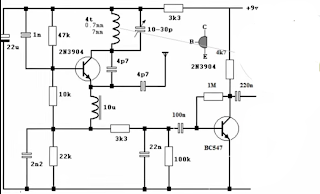fm radio receiver
I can provide you with a basic overview of an FM radio receiver circuit. An FM (Frequency Modulation) radio receiver circuit is designed to receive and demodulate FM radio signals transmitted by radio stations. Here's a simplified explanation of the components and their functions in such a circuit:
1. **Antenna:** The antenna captures the FM radio signals broadcasted by radio stations. It converts these electromagnetic waves into electrical signals that carry the radio frequency information.
2. **RF Amplifier:** The RF (Radio Frequency) amplifier boosts the weak electrical signals from the antenna. It helps improve the signal strength before further processing.
3. **Frequency Mixer:** The mixer combines the amplified RF signal with a local oscillator signal. This process results in the generation of an intermediate frequency (IF) signal. The IF signal simplifies further processing and filtering.
4. **IF Amplifier:** The IF amplifier boosts the intermediate frequency signal's amplitude to improve signal-to-noise ratio and prepare it for demodulation.
5. **Demodulator/Detector:** In FM radio, frequency modulation is used to encode audio information onto the carrier signal. The demodulator/detector extracts this audio information by converting frequency variations back into voltage variations. The most common FM demodulator is the "Phase-Locked Loop" (PLL) detector.
6. **Audio Amplifier:** The demodulated audio signal is usually weak. An audio amplifier is used to amplify this signal to a level suitable for driving a speaker.
7. **Speaker:** The amplified audio signal is sent to a speaker, which converts the electrical signal into sound that you can hear.
8. **Volume and Tuning Control:** Most radio receivers have controls for adjusting the volume and tuning to different radio stations. These controls are connected to the relevant parts of the circuit.
9. **Power Supply:** The entire circuit requires a power supply to operate. This can be provided by batteries or an external power source.
Keep in mind that this is a simplified explanation of an FM radio receiver circuit. Modern radio receivers might incorporate additional features such as digital tuning, display screens, stereo decoding, and more. Additionally, actual circuit designs may vary depending on factors like performance requirements, component availability, and design considerations.
If you're interested in building an FM radio receiver circuit, you'll need a detailed circuit diagram and an understanding of electronics to assemble the components correctly. You can find circuit diagrams and tutorials online that provide step-by-step instructions for building such circuits.
Tags
FM Radio


